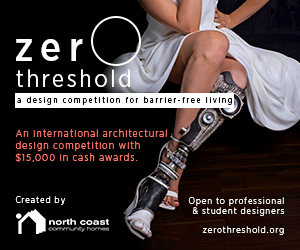In November 2018, we awarded a $149,800 grant to North Coast Community Homes Inc. supporting an international design accessibility challenge to stimulate innovative thinking around affordable and accessible living in Cleveland’s Old Brooklyn neighborhood. In this guest blog, legendary Cleveland architect Robert P. Madison explains the significance of the ZeroThreshold design competition. The competition is currently accepting entries and the deadline to register is June 28, 2019. Learn more here.
By Robert Madison
When I started in architecture in 1954, there wasn’t such a thing as a “design competition.” Now they’re everywhere. They’ve become a vehicle, a way for new ideas to happen and for architects to push new ideas – sometimes past what’s practical. But that’s how we get great inspiration sometimes, isn’t it? Sometimes what isn’t practical, what is unusual, gets us thinking in a new and different way and opens the door for people.
The Cleveland Foundation has helped fund a design competition that I believe is also opening the door for people. ZeroThreshold is a design competition that asks architects to design for accessibility differently. The competition wants us to think about how accessibility looks and feels in the space of a home or in the community. I think that’s an interesting question and challenge.
 The competition is about homes and neighborhoods, but the image on the competition materials is this futuristic looking prosthetic leg. It’s a metaphor, I think, for how we need to look at accessibility differently. A prosthetic leg is really meant to do one thing: help someone walk. The focus has been functional. But now, with new designs and innovation, a prosthetic is more than just a functional solution to overcome a disability. A prosthetic can be about a person reclaiming their disability and expressing who they are and how they want to be seen. ZeroThreshold is asking us to consider some of those same factors, but for homes. I think it’s about time.
The competition is about homes and neighborhoods, but the image on the competition materials is this futuristic looking prosthetic leg. It’s a metaphor, I think, for how we need to look at accessibility differently. A prosthetic leg is really meant to do one thing: help someone walk. The focus has been functional. But now, with new designs and innovation, a prosthetic is more than just a functional solution to overcome a disability. A prosthetic can be about a person reclaiming their disability and expressing who they are and how they want to be seen. ZeroThreshold is asking us to consider some of those same factors, but for homes. I think it’s about time.
When we’re designing a space, I think about how that space helps produce a product we want. For example, with a school it’s better students because the space helps engage them in their education. For homes, it’s stronger communities. When a person feels safe and comfortable in their home they have a space from which they can belong to and engage with the community. It’s a nest that they can fly out from and return to.
To be clear, this new ZeroThreshold competition isn’t just about ideas for a new ramp or how to make things pretty. The focus is to get designers to put forward ideas that are new and different, that push boundaries and open doors. They also want ideas that can be built, because they will be built. The Cleveland Foundation has said it will help get at least one of these ideas constructed in the Old Brooklyn neighborhood of Cleveland, OH. This will get the ball rolling and hopefully be the first step to more accessible housing throughout the community.
We need more homes that older people can live safely in. We need more spaces and more communities that older people or people with different disabilities can be in and engage in. I’m hopeful that if the architectural community in Cleveland and other places step up, we can get there. I think this competition is one way to move us in that direction.
The ZeroThreshold competition is opening the door with some bold and audacious goals. I’m looking forward to seeing what’s on the other side.



